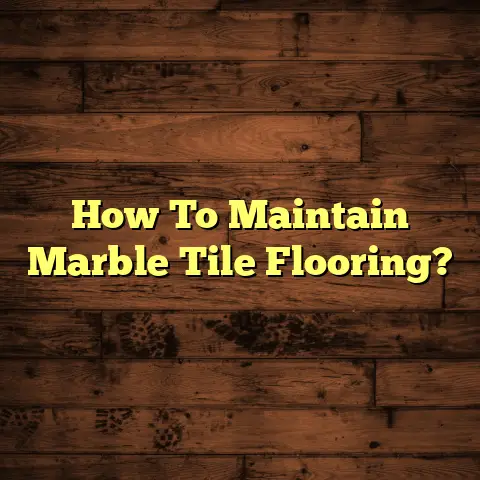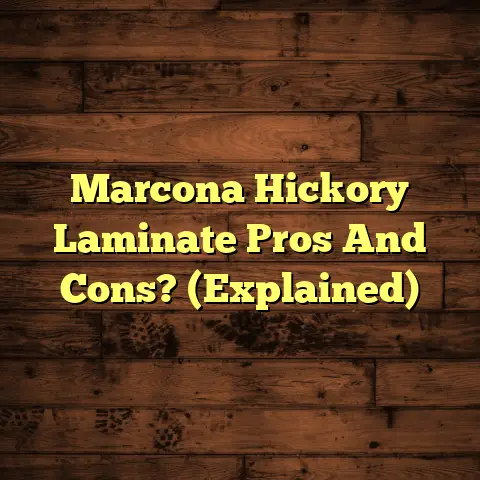Is Fabuloso Okay To Use On Wood Floors? (Explained)
Have you ever wondered if Fabuloso is safe to use on your beautiful wood floors?
I certainly did when I started my journey as a flooring contractor.
After all, wood floors are an investment worth protecting.
Over the years, I’ve come across countless cleaning products, and Fabuloso is one that seems to pop up in many conversations.
The bright colors and enticing scents can be quite appealing, but is it truly suitable for wood floors?
Let me share my insights based on experience, research, and a bit of trial and error.
The Appeal of Fabuloso
Fabuloso has become a go-to cleaning solution for many households because of its pleasant fragrances and ability to tackle various surfaces.
When I first heard about it, I was intrigued by its versatility.
It’s marketed as a multi-surface cleaner, which makes it tempting to reach for whenever I needed to clean floors.
But then the question lingered: Is it safe for wood?
My Experience with Fabuloso
I remember the first time I used Fabuloso on a client’s hardwood floors.
The owner raved about how clean and fresh it made her home smell.
However, I couldn’t shake the feeling of uncertainty.
After all, wood floors require special care.
After applying the cleaner as instructed, I noticed that while the floor looked shiny and smelled great, there was a slight residue left behind.
This led me to dig deeper into the product’s ingredients and how they interact with wood finishes.
Ingredients Matter
Fabuloso contains surfactants that help lift dirt and grime, but these same chemicals can sometimes leave a film on finished wood.
This film can make the floor appear dull over time as it builds up.
So while it may clean initially, it could cause long-term issues.
Comparing Cleaning Products
In my quest for the best cleaning solution for wood floors, I experimented with several alternatives.
Here are a few options I tried:
- Vinegar and Water: A classic remedy!
Mixing equal parts vinegar and water works wonders for cleaning without leaving a residue.
However, be cautious—too much vinegar can damage finishes if used frequently. - pH-Balanced Cleaners: These are specifically designed for wood floors.
They won’t strip away the finish or leave behind any residue.
I found these to be effective without the worry. - Soap-Free Cleaners: These cleaners are often gentle yet effective.
They clean without leaving any film, unlike some multi-surface cleaners.
The Science Behind Wood Floor Care
To understand why certain products work better than others on wood floors, let’s explore some technical details.
Wood is a natural material that expands and contracts with changes in humidity and temperature.
This movement can create micro-gaps in the surface finish.
If cleaning products leave residues, those residues can accumulate in these gaps, leading to dullness and wear over time.
Wood Finishes: Most hardwood floors are sealed with finishes like polyurethane or varnish to protect them from moisture and wear.
These finishes are designed to repel water and dirt but can be compromised by harsh cleaners or improper maintenance.
Challenges Faced
One challenge I encountered while educating clients about cleaning their wood floors was avoiding misinformation.
Many believed that any cleaner could be used without consequence.
I often had to clarify that while Fabuloso might seem harmless, its long-term effects could be detrimental.
During one project, a homeowner insisted on using Fabuloso despite my recommendations against it.
A few months later, they called me back, frustrated that their once-lustrous floors had lost their shine.
This experience reinforced the need for clear communication about proper maintenance practices.
Cost Estimation with FloorTally
As a flooring contractor, keeping track of costs is crucial.
I often use FloorTally to help with this aspect of my work.
When evaluating cleaning products or even planning maintenance for wooden floors, FloorTally assists me in creating accurate estimates by pulling local rates for materials and labor.
For instance, if a client wants to refinish their hardwood floors after years of using products like Fabuloso, FloorTally helps me estimate costs effectively.
It calculates not just the materials needed but also the labor involved in removal and refinishing processes.
The Refinishing Process
Refinishing hardwood floors can be a significant investment but also a rewarding one.
Here’s how I typically approach this process:
- Assessment: First, I assess the condition of the floors.
Are there deep scratches?
Is there discoloration?
This helps determine whether refinishing is necessary or if a good cleaning would suffice. - Preparation: Before starting any work, I ensure the area is clear of furniture and rugs.
This step is crucial for safety and efficiency. - Sanding: Using a drum sander, I sand down the top layer of the wood to remove any finish and surface damage.
This process creates dust, so I always wear protective gear and use dust containment systems. - Staining (Optional): Depending on the client’s preference, I may apply a stain to change the wood color.
It’s essential to test stains on a small area first to see how the wood reacts. - Finishing: Once the stain is dry, I apply multiple coats of polyurethane or another finish to protect the wood.
- Final Inspection: After everything dries, I conduct a thorough inspection to ensure quality.
This entire process can take several days to complete, depending on the size of the area and drying times between coats.
Actionable Tips for Maintaining Wood Floors
Here are some practical tips based on my experiences:
- Avoid Excess Water: Water can seep into seams and damage wood.
Use a damp mop rather than soaking wet. - Regular Dusting: Use a microfiber cloth or broom to remove dust and dirt regularly.
This prevents scratches. - Test Cleaners: Always test a new cleaner in a small area first to ensure it doesn’t affect the finish.
- Use Rugs: Place rugs in high-traffic areas to protect your floors from wear and tear.
- Educate Yourself: Stay informed about the best practices for maintaining your specific type of flooring.
The Importance of Choosing the Right Cleaner
Choosing the right cleaner is crucial for maintaining your wood floors’ beauty and longevity.
Here are some additional considerations:
- pH Levels: Look for cleaners with neutral pH levels (around 7).
Harsh alkaline or acidic cleaners can strip finishes and damage wood fibers. - Read Labels: Always read product labels before use.
Some cleaners may claim to be safe for all surfaces but contain ingredients that could harm wood. - Seek Recommendations: Don’t hesitate to ask fellow contractors or flooring specialists for their recommendations based on experience.
- Consider Environmental Factors: If you live in an area with high humidity or temperature fluctuations, choose products designed for those specific conditions.
Comparing Fabuloso with Other Cleaners
Let’s take a closer look at how Fabuloso stacks up against other popular wood floor cleaning products:
1. Fabuloso vs. Vinegar and Water
- Effectiveness: Both can clean well; however, vinegar-water solutions are less likely to leave residues.
- Safety: Vinegar is generally safer on finishes when diluted properly.
- Cost: Vinegar is usually more affordable than commercial cleaners like Fabuloso.
2. Fabuloso vs. pH-Balanced Cleaners
- Effectiveness: pH-balanced cleaners are specifically formulated for wood floors, making them a better choice overall.
- Safety: They won’t damage finishes or leave residues.
- Cost: pH-balanced cleaners may be slightly more expensive than Fabuloso but are worth the investment for maintaining floor integrity.
3. Fabuloso vs. Soap-Free Cleaners
- Effectiveness: Soap-free cleaners clean effectively without leaving residues.
- Safety: Like pH-balanced cleaners, they are safe for finishes.
- Cost: While generally more costly than Fabuloso, they provide value through protective qualities.
Personal Anecdotes
Reflecting on my experiences with clients has taught me valuable lessons about floor care.
For example, one family had young children who frequently spilled juice on their hardwood floors.
Initially, they used Fabuloso to clean up messes quickly because of its easy application.
However, over time, they noticed sticky spots where spills had occurred repeatedly.
After discussing alternatives, they switched to vinegar-water solutions and occasional professional cleanings using pH-balanced products.
Their floors regained their luster within weeks!
Another instance involved an elderly couple who were unaware of how their cleaning habits were affecting their beautiful oak floors.
They relied heavily on Fabuloso due to its scent and convenience but had never considered its long-term impact until they noticed wear patterns developing.
After our consultation, we devised a new care routine that included dusting with microfiber cloths daily and using gentle cleaners specifically designed for wood surfaces twice a month.
These real-life experiences highlight not only the importance of product choice but also how education plays a significant role in maintaining beautiful wood floors over time.
Conclusion
So, is Fabuloso okay to use on wood floors?
While it may clean effectively in the short term, I wouldn’t recommend it for long-term maintenance due to potential residue buildup and damage over time.
Instead, consider alternatives like vinegar-water solutions or pH-balanced cleaners that will keep your wood looking beautiful without compromising its integrity.
Always remember to follow up any cleaning with proper drying methods to protect your investment.
By sharing my experiences and insights, I hope to help you make informed decisions about your wood floor care.
After all, maintaining those beautiful floors is worth every effort!
If you have any questions or want specific advice tailored to your situation, feel free to reach out!
Your flooring deserves the best care possible!





